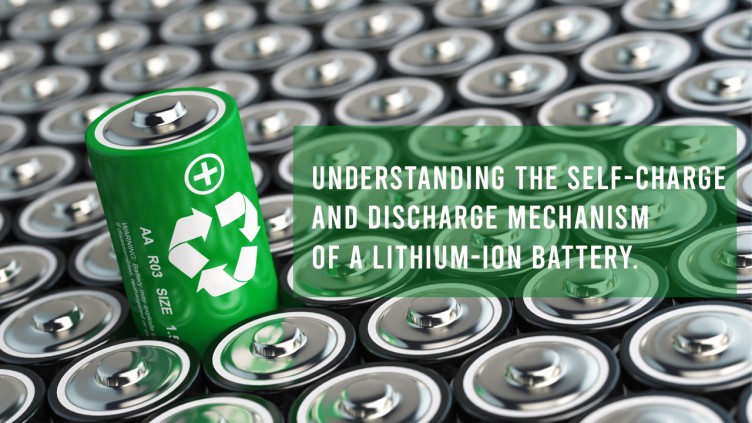Self-charge and discharge mechanism of lithium-ion batteries is a major aspect. Do you know Lithium-ion batteries are rechargeable batteries that use lithium ions to store energy? They are known for having a low self-discharge rate compared to other rechargeable batteries, typically losing only about 5% of their monthly charge. This means that they can be left unused for long periods of time without losing their charge. The movement of lithium ions between the anode and cathode of the battery mainly controls the charge and discharge of lithium-ion batteries. During charging, lithium ions move from the anode to the cathode, storing energy. During discharge, the lithium ions move from the cathode to the anode, releasing energy. This cycle can be repeated multiple times for the same battery. The rate at which lithium-ion batteries charge and discharge depends on several factors, including the type of electrolyte used, the size and composition of the electrodes, and the battery’s temperature. The rate of charge and discharge is also affected by the design of the battery, such as how the electrodes are arranged. Overall, the charge and discharge of lithium-ion batteries is a complex process that can be affected by many different factors. However, lithium-ion batteries are still a very popular choice for many applications due to their high energy density and low self-discharge rate.

Importance of self-discharge
The self-discharge of lithium-ion batteries is an important factor in ensuring the long-term performance of the battery. Self-discharge occurs when the battery is not in use and is a natural process that occurs with all battery types. A lithium-ion battery typically self-discharges at a rate of about 5% per month, depending on the type and temperature of the battery. This self-discharge rate can be reduced by maintaining the battery storage voltage above the minimum voltage and storing the battery at lower temperatures. By managing self-discharge, the battery can maintain its charge capacity over time and provide a longer lifespan.
Self-discharge mechanism
Self-discharge is a phenomenon in which the stored electrical energy of a battery is gradually lost over time even when the battery is not being used. This phenomenon occurs due to a variety of factors, including chemical reactions, leakage, and temperature. In order to reduce the rate of self-discharge, various methods such as using lower temperatures and special coatings are used.
Effect of self-discharge of a storage battery
The self-discharge of a storage battery is the loss of charge that occurs over time, even when the battery is not in use. This can affect the battery’s performance and shorten its lifespan. Self-discharge can be caused by internal chemical reactions, environmental factors, and other factors. It can reduce the battery’s capacity and performance and can also lead to early battery failure. Self-discharge can be minimized by proper storage and maintenance, but the effects of self-discharge cannot be completely eliminated.
The distinction between chemical and physical self-discharge
Chemical self-discharge occurs when an electrochemical reaction reduces the voltage of a battery over time. This happens when the chemicals in the battery react with the electrolyte, producing other elements. Physical self-discharge occurs when the terminal voltage of a battery drops as a result of heat, vibration, or other mechanical action. This process can be accelerated by exposure to high temperatures, which causes the ionic charge carriers to move faster, leading to a quicker voltage loss.
Self-discharge test
Self-discharge tests are performed to measure the rate at which a battery discharges itself over time. This is important in order to determine the battery’s capacity, reliability, and performance. The test involves disconnecting the battery from an electrical circuit and measuring the voltage level over a certain period of time. The voltage level should decrease steadily as the battery discharges. If the voltage level does not decrease as expected, then the battery may be faulty or have a shorter lifespan than expected.
Types of self-discharge tests
A self-discharge test of a battery is a type of test used to measure the rate at which a battery loses its charge over time when it is not connected to a load or other devices. This test is typically done by measuring the voltage of the battery over a given period of time and can be used to assess the health of a battery. It can also be used to determine the battery’s capacity and expected life span. Below mentioned are the type of self-discharge tests:
1. Continuous self-discharge test
2. Intermittent self-discharge test
3. Short-term self-discharge test
4. Long-term self-discharge test
5. Vibration self-discharge test
6. Submersion self-discharge test
7. High-temperature self-discharge test
8. Low-temperature self-discharge test
Influencing factors and control points of self-discharge
- The internal resistance of the battery: The internal resistance of the battery affects the self-discharge rate since it determines the amount of current that can be drawn from the battery. High internal resistance results in a lower self-discharge rate.
Control point: Select a battery with lower internal resistance.
- Temperature: Temperature affects the electrochemical reaction inside the battery, which in turn affects the self-discharge rate. Higher temperature results in a higher self-discharge rate.
Control point: Keeping the temperature at an optimum level for the battery.
- State of charge: Self-discharge rate increases as the state of charge of the battery decreases.
Control point: Maintaining the state of charge of the battery at an optimum level.
- Age: As the battery ages, its self-discharge rate increases.
Control point: Regular maintenance and replacing the battery after its life cycle.
For more articles like Self-charge and discharge mechanism continue here.
For More Updates Follow Us

No responses yet